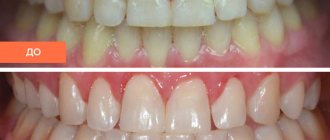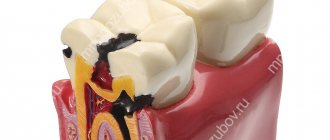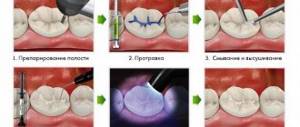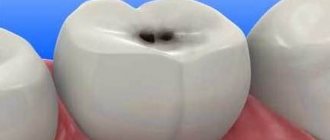One of the most dangerous dental diseases is the decompensated form of caries. Its name means that the development of a pathogenic process in the tooth is in no way compensated by the body’s reactions, and therefore occurs very quickly. The patient will most likely have to face complications in the form of pulpitis and periodontitis, when the tooth not only hurts, but there is a real risk of losing it.
Dental caries in decompensated form
The decompensated form of caries is, in fact, an intensively developing caries, a pathological process that occurs very actively in the hard tissues of the tooth and leads to their rapid destruction. Often, carious cavities in this form of the disease are multiple and are present in many teeth at once.
In dentistry, there are several classifications of caries. When classified according to the severity of the process, the following forms of the disease are distinguished:
- compensated;
- subcompensated;
- decompensated.
Decompensated (acute, blooming) caries is the most dangerous form, since it develops much faster than in compensated and subcompensated forms. Acute caries can lead to tooth loss in just a few weeks. In this case, enamel and dentin are destroyed very quickly, and the transition from the initial stage to the deep stage occurs many times faster than in the chronic course of the disease.
On a note!
The very name “decompensated form” means that the development of the carious process is in no way compensated by the body’s responses. It is in the absence of any obstacles that the process proceeds especially quickly and with very serious consequences.
The reasons for the development of pathology in the decompensated form are reduced bactericidal properties of saliva, lack of oral hygiene, unfavorable diet and hereditary factors, and unhealthy lifestyle. Sometimes acute caries develops due to weakened immunity.
Acute caries is most dangerous when the tooth is not treated. But unlike other forms, it is easily detected. The main symptoms that signal the development of a serious problem are the following:
- multiple noticeable external manifestations of caries on the surface of tooth enamel;
- acute prolonged pain in the teeth;
- strong reaction to cold, chemical, mechanical irritants
Important!
If the carious lesion on the surface is very small, but the described symptoms are present, you should not postpone a visit to the doctor. Under a small entrance there may be a large carious cavity. An additional clue will be the loss of shine of the enamel, its grayish or chalky tint.
A dentist can easily diagnose a decompensated form of caries based on the following signs:
- wide base of carious form;
- narrow entrance;
- a large amount of softened dentin;
- sharp pain during probing.
A probe and a dental mirror are usually sufficient for diagnosis. But if a carious cavity in a separate tooth is hidden from view, an X-ray is taken or transillumination is used (a method of “highlighting” hidden carious areas with a bright light flux from lamps). Also, in the decompensated form, fissurotomy is often used (this is a method of diagnostic search for hidden caries using prophylactic excision of “darkened” pits and enamel depressions on chewing teeth).
The decompensated form of caries develops the faster, the lower the body's resistance. Therefore, the acute form is most often observed in people with weakened immune systems.
There are several groups of patients who are most at risk of developing this pathology:
- children with baby teeth;
- people who have recently had infectious diseases;
- people with metabolic disorders;
- elderly people with weakened immune systems.
Caries
- Caries
- Pulpitis
- Gingivitis
- Periodontitis
- Periodontal disease
- Periodontitis
- Pericoronitis
- Peri-implantitis
- Fluorosis
- Stomatitis
- Tooth cyst
- Caries
- Causes
- Stages
- Front tooth
- Cervical
- Treatment
- Prevention
The concept of “caries,” like most medical terms, came to us from the Latin language, in which the word means “rotting.” Indeed, at its core, the process of gradual destruction of dental tissue under the influence of internal and external factors visually represents tooth decay.
Stages of caries
- Caries begins in the form of pigmentation of a small area of enamel. At first it has a white shade, lighter than that of the tooth itself.
- Then the spot begins to darken, gradually acquiring a yellowish and brown color. Detection of the disease at this stage contributes to the preservation of natural tooth enamel through the timely use of remineralizing therapy.
- With further development, the affected area becomes rough and reacts to changes in the pH balance of the oral cavity when consuming sour, sweet, and salty foods. To treat this stage of caries, mechanical treatment of the spot will be required before remineralization.
- When a carious cavity appears in a tooth, the third stage of the disease is determined. The intensity and duration of pain depends on the depth of the lesion. In this case, it will be possible to restore the integrity of the tooth only by replacing the defect with artificial materials. Damaged tissue is first removed, and the cavity is subjected to antiseptic treatment.
If caries comes close to the root canals, then it is called deep. Timely and qualified treatment will help preserve a living tooth at this stage, even in cases of severe dentin damage. Anesthesia is often required before preparation. If the pulp tissue is affected, they resort to depulpation. When restoring the anatomical shape of a tooth, along with filling material, warm antiseptic solutions, medicinal pads containing calcium, fluoride-containing sealants for insulation, dentin and enamel adhesives are used. Upon completion of filling, the surface is ground and polished.
Forms of the disease
Based on the nature of the intensity of the disease, three forms of caries activity are distinguished:
- compensated
, when caries remains in the spot stage for a long period, without forming a cavity, or the formed carious cavity does not progress for a long time (this form can also be called chronic); - subcompensated
, that is, the rate of development of the disease corresponds to the average statistical indicators for a specific age group (in other words, the classic form of caries); - decompensated
, characterized by rapid progression and generalization of the lesion (defined as an acute form of the disease).
Classification of caries by localization
Modern medicine distinguishes six classes of carious cavities according to their location. This classification was proposed by the American scientist Black. Initially, this division was developed in order to streamline the methods of preparation and filling. That is, for each class a certain treatment technique was implied. So, caries has the following types of localization:
- Class 1 - carious cavities that arise in natural pits, grooves, and fissures of teeth. Most common.
- Class 2 - caries located on the approximal (medial or distal) surfaces of premolars and molars. Rarely encountered. Diagnosed using x-ray.
- Class 3 - carious cavities located on the approximal (medial or distal) surfaces of the canines or incisors, not affecting the cutting edge or angle of the crown. Caries on the distal side causes diagnostic difficulties.
- Class 4 - the location is the same as in the third class, but the affected area includes the cutting edge or part of it near the canines or incisors.
- Class 5 - the occurrence of disease near the neck of the teeth, that is, cervical caries. Characterized by rapid flow.
- Class 6 - carious cavities located in the cusps of molars or in the cutting edge of the front teeth. Was allocated much later.
The danger of decompensated form
Acute caries is dangerous for many reasons. The advanced form of the disease often leads to the following problems:
- development of pulpitis and periodontitis;
- development of periodontitis;
- tooth splitting;
- tooth loss.
In addition, the decompensated form is a signal of a disruption in the functioning of the entire organism. Untreated caries is often a consequence of decreased saliva production and a decrease in its bactericidal properties, which affects the general condition of the oral cavity as a whole. In pregnant women, this can affect the general physical condition of the expectant mother and the health of the fetus.
Why does the disease occur?
Deep caries can appear in children from three, or even from two years old, if the previous stages of the disease were left unattended.
There may be several reasons.
- An unhealthy lifestyle for the expectant mother is smoking and drinking alcohol in the first trimester of pregnancy.
- The consequence of infections and severe toxicosis.
- Prematurity.
- Infectious diseases suffered by a child in the first months of life.
- Malocclusion.
- Dental caries in the baby's parents.
- Frequent feeding of the child with pureed foods, lack of solid foods in the diet, which leads to insufficient saliva production.
- Excessive amounts of sweets, which promotes the proliferation of pathogenic bacteria, carbohydrate fermentation processes and the formation of lactic acid.
- Lack of foods with phosphorus, fluorine and calcium in the diet, which leads to demineralization of teeth and their gradual destruction.
- Insufficient hygiene. Neglecting simple rules - brushing your teeth twice a day and rinsing your mouth after eating - also negatively affects dental health.
Types of disease
Acute caries has two forms:
- medium spicy;
- deep spicy.
The difference between medium and deep acute forms lies in the size of the carious cavity. With moderate acute caries, there is no need to remove the nerve, and the tooth can be treated and restored. In case of deep acute caries, depulpation is usually required, and in case of severe tooth decay it is necessary to remove it.
Since in the acute form of the pathology the destruction of tooth tissue occurs very quickly, and children are most susceptible to the disease, in pediatric dentistry the following grouping is accepted:
- Compensated form (I group);
- Subcompensated (group II);
- Decompensated (group III).
Groups have been created to carry out clinical observation.
Pediatric dentist T. F. Vinogradova identified several dispensary groups:
- practically healthy teeth;
- compensated form;
- subcompensated form;
- decompensated form.
Children with a compensated form are examined once a year, with an undercompensated form - 2 times, with a decompensated form - 3 times. Planned sanitation reduces the risk of complications in the development of caries, the number of fillings and extracted teeth decreases. The need for treatment is also reduced by almost half, and the number of annual scheduled examinations is reduced.
Monitoring risk groups allows you to keep records based on a number of criteria:
- general prevalence of caries;
- anamnesis of life;
- health status;
- severity of the disease.
Planned sanitation and timely diagnosis of caries in adults and children make it possible not only to cure it in the initial stages, but also to prevent the development of blooming caries.
Treatment of compensated forms of caries
The compensated form of caries in dentistry is treated depending on the stage of the disease:
- Remineralizing therapy. The procedure for saturating tooth enamel with phosphorus and calcium ions is advisable at the initial stage of the disease and as a preventive measure.
- Deep fluoridation based on preparations with calcium, fluorine and phosphorus allows you to restore enamel tissue if a compensated form of caries is detected at the spot stage.
- Fissure sealing. This is the sealing of the anatomical grooves of the chewing teeth. Most often it is done to children with superficial caries to prevent further tooth decay. After the procedure, food debris stops accumulating in the recesses and bacteria no longer multiply.
- Filling cavities. The method is used when the deep layers of the tooth are damaged. The doctor drills out the infected tissue and, if necessary, removes the pulp. After this, the root canals and the crown part of the tooth are filled with materials specially designed for this purpose.
How is blooming caries treated?
Treatment of decompensated forms of caries can be divided into three stages:
- removal of all tooth tissue affected by caries;
- removal of the nerve (if necessary);
- tooth restoration.
Since blooming caries causes severe pain, all stages of treatment are carried out under local anesthesia or general anesthesia (more often). This means that the procedures are painless for the patient. Modern anesthetics are absolutely safe and hypoallergenic, so this treatment is available even for pregnant women.
Removal of affected tissue is mainly carried out using a drill. But this is not the only possibility. There are also more modern methods: washing out with dental sandblasting, evaporation with a dental laser. Unfortunately, these modern methods do not yet have a good evidence base for their effectiveness for the treatment of serious carious lesions, and are not widely used in our country.
At the next stage of treatment (if necessary), the dental nerve is removed using special equipment. Then the dental canals are cleaned and filled.
Restoration is the last stage of treatment. Using filling materials, the dentist restores the original shape of the tooth.
Treatment of acute caries is a complex and lengthy process. Most often it takes place in two visits. During the first, the affected tissue is removed and medicinal treatment is carried out. During the second visit, the tooth is restored.
How is decompensated caries treated?
This is a fairly common disease that comes in different forms. Our clinic uses a standard treatment method, including the elimination of infected tissue, removal of the dental nerve and tooth restoration.
Often several elements of the dental row are affected at once. And if the doctor concludes that they can be cured in one session, he will be happy to provide this service.
Prevention of decompensated form of the disease
Everyone can prevent the development of acute caries. Even with a hereditary predisposition, dental problems arise due to poor oral hygiene and poor nutrition.
Prevention of the decompensated form of the disease is quite simple. To carry it out you need:
- brush your teeth morning and evening;
- use toothpaste with fluoride;
- clean interdental spaces with dental floss;
- do not consume too cold or hot food or drinks;
- limit the amount of soft and sweet foods, since after eating them, plaque forms on the teeth, which contributes to the demineralization of the enamel;
- Visit the dentist 1-4 times a year.
Planned sanitation of the oral cavity makes it possible to identify caries at the earliest stages and prevent it from developing into an acute form. Regular visits to the doctor allow you to timely detect weaknesses in the care of your teeth and gums, make adjustments and stop their diseases. Therefore, visiting a dental clinic to check the condition of your teeth should become a rule for everyone who cares about their health.
How the disease develops
At the initial stage, a stain appears on the enamel, then its destruction gradually occurs. Most often, there is no pain, so the problem continues to grow.
The consequence of this process is deep caries, which is accompanied by:
- A pronounced reaction to hot, cold and sweet foods;
- Severe pain;
- Tooth decay.
The pain does not subside, the child refuses to eat and cries.
If measures are not taken at this stage, inflammation that is dangerous to health develops - pulpitis or periodontitis.











